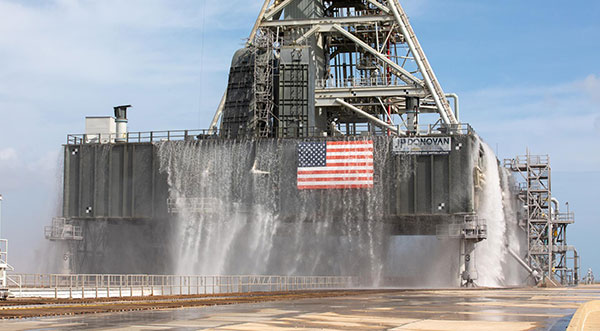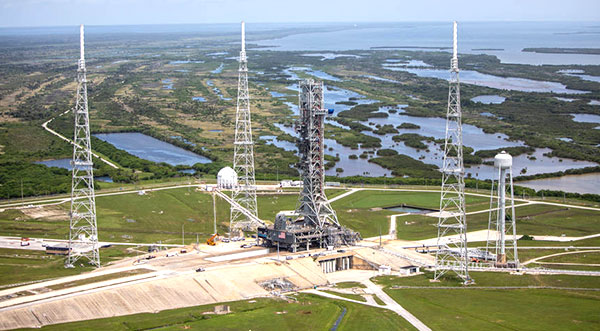WATCH: Launch Complex 39B at Kennedy Space Center Prepared to Support Artemis I Launch
By Space Coast Daily // May 8, 2020
Engineers have replaced or upgraded pad subsystems used for Apollo and Space Shuttle Programs
ABOVE VIDEO: A legacy of the Apollo Program and shuttle era, Launch Pad 39B at NASA’s Kennedy Space Center in Florida is the site of NASA’s return to the Moon and is now ready for Artemis I—an uncrewed mission around the Moon and back.

BREVARD COUNTY • KENNEDY SPACE CENTER, FLORIDA – A legacy of the Apollo Program and shuttle era, Launch Pad 39B at NASA’s Kennedy Space Center in Florida is the site of NASA’s return to the Moon and is now ready for Artemis I—an uncrewed mission around the Moon and back.
For the past few years, Exploration Ground Systems (EGS) has modified and upgraded the launch pad for the Space Launch System (SLS) rocket and Orion spacecraft to help accomplish NASA’s lunar exploration goals.
“Getting the pad ready for Artemis I has transformed the site for a new generation of space exploration,” said Regina Spellman, EGS senior project manager for Pad 39B.
“When I look back on when we first inherited it from the Space Shuttle Program to where we are today, I am so proud of all the amazing things that the team has accomplished.”
Engineers have replaced or upgraded pad subsystems used for Apollo and the Space Shuttle Program to support the powerful SLS rocket and multi-user spaceport.
The guiding principle behind the upgrades and modifications has been to make the area a clean pad, one with no launch support structures on top, which will allow a variety of rockets to launch from the pad.

“The Ground Systems architecture with a clean pad concept minimizes the time the vehicle is out at the pad, exposed to the elements. It also minimizes the amount of exposed infrastructure that has to be maintained between launches,” Spellman said.
The basics that every rocket needs are in place, such as electrical power, a water system, flame trench and safe launch area. The other needs of individual rockets, including access for workers, can be met with the towers, such as a mobile launcher.
During the refurbishment projects, teams removed and replaced 1.3 million feet of copper cables with 300,000 feet of fiber cable.
The water tower for the upgraded sound suppression system holds roughly 400,000 gallons of water, or enough to fill 27 average swimming pools.
At ignition and liftoff, this water is dumped on the mobile launcher and inside the flame trench in less than 30 seconds. The three lightning towers surrounding the pad are each about 600 feet tall – taller than the Vehicle Assembly Building, which is 525 feet tall. They form a linked system of wires above the pad that will protect the launch vehicle during storms.
The refurbished flame trench — the size of one and a half football fields — and new flame deflector will be exposed to a peak temperature of 2,200 degrees Fahrenheit during launch. Technicians installed more than 96,000 heat-resistant bricks on the walls of the flame trench during the refurbishment project.

“The EGS pad team has already ramped up to prepare the pad for the second Artemis mission when we will launch humans,” Spellman said. “Several projects are underway, some even under construction, which will support the flight crew.”
Work now is in progress on a new liquid hydrogen tank as well as an emergency egress system for Artemis II, the first crewed launch.
Apollo 10 was the first mission to begin at Launch Pad 39B when it lifted off May 18, 1969, to rehearse the first Moon landing. Three crews of astronauts launched from the pad to the Skylab space station in 1973.
Three Apollo astronauts who flew the historic Apollo-Soyuz Test Project mission to link up in space also launched from the pad in 1975. In all, 53 space shuttle missions and the Ares I-X test flight launched from the pad between 1986 and 2011.
“The work and the team itself has evolved over the years, but one thing has always been constant, we have always been dedicated to getting Launch Pad 39B back to launching humans to space, farther and safer than ever before,” Spellman said.

CLICK HERE FOR BREVARD COUNTY NEWS













